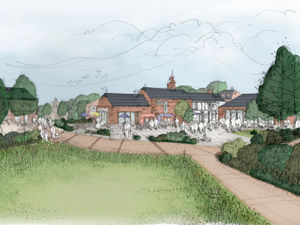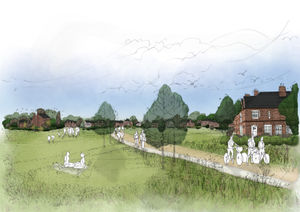Solar panels could provide electricity for all 3,000 homes planned near M54, say developers
Solar panels could provide the electricity for all 3,000 homes planned for a controversial green belt development, according to the organisation behind the project.

The Bradford Estates say that it wants its proposals for land off Junction 3 of the M54 and west of the village of Tong to result in a net-zero-carbon community.
The plans are currently being considered by Shropshire Council and if approved would see the creation of 3,000 homes, and 1.8million sq ft of commercial space on land owned by the estate.
The project has attracted considerable criticism from local campaigners and Wrekin MP Mark Pritchard, but the estate says it would create up to 8,000 jobs and bring an extra £390 million into the county economy each year.
See also:
Bradford Estates’ managing director, Viscount Alexander Newport, says they have commissioned consultants WSP to analyse the project and make recommendations on how to meet net zero carbon status.
He said: “During the current Covid lockdown, we have seen a staggering reduction in carbon levels across the country, and indeed across the UK.
“As we look to the future, we need to ensure that we don’t revert to old habits which will return emissions to pre-pandemic levels. This means a new approach to considering the environmental impact of everything we do, including future developments like J3.
“Shropshire Council has been very clear about the importance of tackling the county’s climate emergency and should be commended for the proactive steps it is taking to achieve its target of becoming net zero carbon from 2030.”
The WSP report outlines how the development can be powered entirely by renewable electricity.
The WSP analysis states that a £23 million investment by Bradford Estates would see 45 per cent of the electricity needed to power the proposed homes and commercial properties generated using ‘roof tile-looking’ solar photovoltaic panels.

According to the consultants the balance would then be sourced through solar photovoltaic panels elsewhere on the 12,000-acre estate.
“In addition to using designs that complement and are in keeping with the local area, the new homes and commercial buildings will incorporate inbuilt solutions to reduce energy consumption,” said Lord Newport.
“This could be achieved through focusing on obvious details like insulation and monitoring, as well as utilising energy efficient technology such as air source heat pumps.”
Lord Newport has also said the intention is to reduce the need for transport by making a self sustainable development, including retail, schools, recreational areas, and doctors’ facilities.
He said: “The WSP report estimates that about 50 per cent of car-bound peak hour trips could be eliminated because of the adjacency of homes to schools and places of work alone."
He added that car charging ports, cycle and walking routes would be part of the plan.





